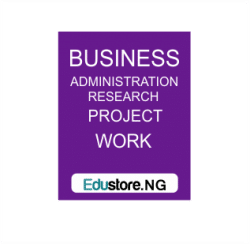CHAPTER ONE
INTRODUCTION
1.1 Background of the Study
Environment of any organization is dynamic in nature due to the forces that operates in it as a result; managerial activities could not be operated freely. The environment of any organization is the aggregate of all conditions, events and influences that surround and affect it, ( Davis, 1975).
The environment is a major source of uncertainty to a business manager and as such both influences the design of any organization and the configuration of any organizational structure, therefore, without a thorough analysis of the environment, a manager finds it almost impossible to make important operational decisions in his organization, which are essential in the attainment of various business objectives.
Organization of every dimension both formal and informal operates in an identifiable environment. Corporate environment can be described as the totality of situations and factors that can have direct or indirect effect on corporate performance in any given organization.
Organization operates in an environment. As a social institution, business organization has an intricate and important relationship with the environment which it interacts (Hellman 1999).In any business organization, the main purpose of such interaction is to maximize profit and well-being of a firm’s constituents. The mechanism of interaction is the interface between the corporate performance and its environment. The dynamic environment in which the organization operates provides opportunities for it to grow, develop and create value and wealth. It also poses threats to corporate performance. The primary concern is how the organization affects people and natural environment as it produces and sells products or services necessary to satisfy customers, stakeholders and other constituents. By building key stakeholders relationships among government agencies, consumer entities, environmental groups and other constituents, an organization can participate and manage issues and concerns that might otherwise have gone undetected until they had grown into major problems(Rainey 2008). This necessitates the analysis of both internal and external environment by the organization. For any business organization to be able to control its growth, change and development, the corporate manager must seek to control the forces which provide the opportunities for growth and change and those which pose threats and demand responses (Inyang, 2004).
The environment changes have been rapid and unpredictable economic variables have been complex as well as customers have been showing complex behaviours both in local and international market. The most dramatic change is exhibited by technology and competitive pressure. It is vivid that technological change is vital for any corporate firm, since it is a major driven force of competition in industries as well as sources of sustainable competitive advantage. Therefore, a manager will find it difficult to make important operational decisions which are vital to the attainment of various business objectives without a thorough assessment of the environmental factors in an organization.
Hence, business organization cannot successfully operate in isolation, it has to exist and operate within an environment where there is complex interplay between human resources, material resources and other system. We ought to realize that an organization is an integral part of it environment and that they mutually interdependent where the environment plays the role of providing the resources and opportunities to organization for its existence and the organization in turn, offers its goods and services to the people living in its environment(Imaga, 1996).
The environment which consist of the external or macro environment comprise of the economic, social, cultural, political, technological, competitive and natural forces which encroach on the business operations, while that of internal or micro environment concern mainly with the functional aspect of business organisation which include marketing, production, finance, human resources and administration.
The key to survival in the modern competitive environment depends on clearly defined objectives and efficient and effective practices to achieve corporate objectives. However, it is very important for a manager to specifically adopt strategic planning which is essential to company’s survival and growth. Failure for organization to adequately adapt to the environment is a major cause of organizational failure.
Adaptability requires flexibility to identify and assess emerging issues and trends, that might prove to be critical to the organization in future. By expecting future changes and their implications, organizations can avoid the worst problem and prepare for those that are unavoidable and take advantage of possible opportunities.
DOWNLOAD COMPLETE WORK- For Reference Only: Materials are for research, citation, and idea generation purposes and not for submission as your original final year project work.
- Avoid Plagiarism: Do not copy or submit this content as your own project. Doing so may result in academic consequences.
- Use as a Framework: This complete project research material should guide the development of your own final year project work.
- Academic Access: This platform is designed to reduce the stress of visiting school libraries by providing easy access to research materials.
- Institutional Support: Tertiary institutions encourage the review of previous academic works such as journals and theses.
- Open Education: The site is maintained through paid subscriptions to continue offering open access educational resources.






